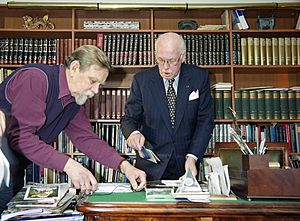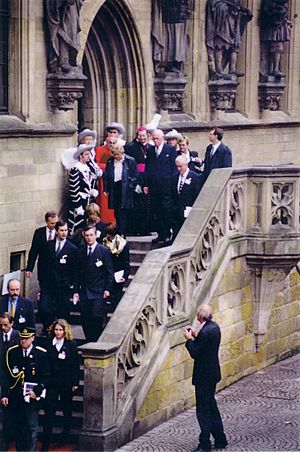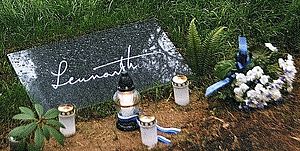Lennart Meri facts for kids
Quick facts for kids
Lennart Meri
|
|
|---|---|

Meri in 1998
|
|
| President of Estonia | |
| In office 6 October 1992 – 8 October 2001 |
|
| Prime Minister | Mart Laar Andres Tarand Tiit Vähi Mart Siimann Mart Laar |
| Preceded by | Konstantin Päts (Last President before Soviet occupation in 1940) Heinrich Mark (Last head of state in exile) Arnold Rüütel Chairman of the Supreme Council of the Republic of Estonia |
| Succeeded by | Arnold Rüütel |
| Minister of Foreign Affairs | |
| In office April 1990 – March 1992 |
|
| Prime Minister | Edgar Savisaar Tiit Vähi |
| Preceded by | Olev Olesk (in exile) |
| Succeeded by | Jaan Manitski |
| Personal details | |
| Born |
Lennart-Georg Meri
29 March 1929 Tallinn, Estonia |
| Died | 14 March 2006 (aged 76) Tallinn, Estonia |
| Political party | Pro Patria Union |
| Spouses |
Regina Ojavere
(m. 1953; div. 1982)Helle Pihlak
(m. 1992) |
| Children | 3 |
| Alma mater | University of Tartu |
| Profession |
|
Lennart Georg Meri (born March 29, 1929 – died March 14, 2006) was an important Estonian writer, film director, and statesman. He served as Estonia's foreign minister from 1990 to 1992. Later, he became the President of Estonia from 1992 to 2001. He played a key role in helping Estonia become an independent country again after being part of the Soviet Union.
Contents
Early Life and Challenges
Lennart Meri was born in Tallinn, Estonia. His father was a diplomat and his mother was Estonian Swedish. Because of his father's job, Lennart lived in many countries and went to nine different schools. He learned to speak five languages fluently, including Finnish, French, German, English, and Russian. His favorite school memories were from Paris.
In 1940, when Lennart was 11, the Soviet Union took over Estonia. In 1941, his family was forced to move to Siberia with thousands of other Estonians. This was a very difficult time. Lennart, at just 12 years old, worked as a lumberjack and potato peeler to help his family survive.
While in Siberia, Lennart became very interested in the different languages spoken around him. He learned about the "Finno-Ugric" language family, which includes Estonian. This interest in different cultures and languages stayed with him throughout his life.
After surviving their time in exile, the Meri family returned to Estonia. Lennart studied history and languages at the University of Tartu. He graduated with honors in 1953. Because of the political situation, he couldn't work as a historian. Instead, he became a dramatist and radio producer. He also made several films that were highly praised.
A Life as a Writer and Filmmaker
Lennart Meri wrote his first book after traveling to the Tian Shan Mountains and the Kara Kum Desert in 1958. His book was very popular. He had started earning money from his writing even as a student, helping his family when his father was arrested.
One of his films, The Winds of the Milky Way, was made with help from Finland and Hungary. The Soviet Union banned it, but it still won an award at the New York Film Festival. His films and writings were even used to teach students in Finland. In 1986, he received an honorary degree from Helsinki University.
Meri believed that traveling helps people understand the world better. He wrote that "Traveling is the only passion that doesn't need to feel shy in front of intellect." He thought that even city people have a natural desire to explore nature.
His travel book, Virmaliste Väraval (At the Gate of the Northern Lights), was a huge success in the Soviet Union. In this book, he connected his own travels with the journeys of famous explorers from the past. He imagined seeing the same mountains that Vitus Bering and James Cook had seen centuries before.
Perhaps his most famous book is Hõbevalge (Silver White), published in 1976. This book explores the ancient history of Estonia and the Baltic Sea region. Meri used historical records and scientific research, mixed with his own ideas. He even suggested that the legendary land of Thule might be connected to the Kaali crater lake in Saaremaa, Estonia. He also wrote about how Estonia might have helped Europe in ancient times by providing grain and other goods.
In 1988, Meri started the Estonian Institute. This group helped connect Estonia with Western countries and allowed Estonian students to study abroad. He also appeared in a film called The Singing Revolution, talking about how the Soviet Union was collapsing.
Becoming a Political Leader
For many years, the Soviet government did not let Lennart Meri travel freely. But in the late 1970s, he finally got permission to visit Finland. He used this chance to remind the world that Estonia was still under Soviet rule. He met with politicians and journalists to share Estonia's story. He was also the first Estonian to speak out internationally against a Soviet plan to mine phosphorite in Estonia, which would have harmed the environment.
These environmental protests grew into a bigger movement against Soviet rule, known as the "Singing Revolution". Lennart Meri's speeches about Estonia's future were very powerful and heard around the world. In 1988, he helped start the Estonian Popular Front, a group that worked for Estonia's independence.
Foreign Minister (1990-1992)
After Estonia held its first free elections in 1990, Lennart Meri became the Minister of Foreign Affairs. His first job was to create a new Ministry of Foreign Affairs. He gathered a team of smart, young people to help Estonia communicate with other countries. He traveled a lot, meeting with leaders and foreign ministers from around the world. He even gave a speech at NATO Headquarters in Brussels, which was a big step for an Eastern European country.
In 1992, Lennart Meri also helped create the Council of the Baltic Sea States (CBSS). This group helps countries around the Baltic Sea work together.
President of Estonia (1992-2001)
After a short time as Estonia's Ambassador to Finland, Lennart Meri became the second President of Estonia on October 6, 1992. He was the first president since Estonia regained its independence from the Soviet Union. He was the candidate for the Pro Patria Union party.
During his time as president, Meri spoke out against ideas that could threaten Estonia's independence. He was recognized for his openness and honesty. In 1994, the Estonian Newspaper Association named him the "Year's Press Friend" for being so good at communicating with the media. He received this award again in 1999.
Lennart Meri was re-elected for a second term as president in 1996. He served until 2001.
Helping Others
Lennart Meri cared deeply about human rights. He worked to help German refugees and other people in Europe who had been forced to leave their homes. He was part of a group that gave out the Franz Werfel Human Rights Award. In 1999, he received a high honor from a German group that helps people who were expelled from their homes.
Personal Life
Lennart Meri was married twice and had three children: Mart, Kristjan, and Tuule. He also had five grandchildren. His second wife, Helle Meri, was an actress.
In 1998, a French newspaper called La Vie chose him as the "European of the Year."
Death and Legacy
Lennart Meri passed away on March 14, 2006, just before his 77th birthday. He had been sick for several months. Many leaders from around the world shared their sadness. Estonia's next president, Arnold Rüütel, said that Meri "restored the presidency and built up the Republic of Estonia." The President of Finland called him "a close and sincere friend."
Lennart Meri is remembered as one of Estonia's most respected presidents. In his honor, Tallinn Airport was renamed Lennart Meri Tallinn International Airport in 2009.
Awards and Decorations
- Merited Writer of Estonian SSR (1979)
- Correspondent member of the European Academy of Science, Art and Literature (1989)
- Honorary Doctor of Helsinki University (1986)
- Liberal International and Coudenhove-Kalergi award
- Golden Plate Award of the American Academy of Achievement (2002)
Honours
 Estonia: Collar of the Order of the National Coat of Arms (Posthumous 2008)
Estonia: Collar of the Order of the National Coat of Arms (Posthumous 2008) Estonia: 1st Class of the Order of the National Coat of Arms (2006)
Estonia: 1st Class of the Order of the National Coat of Arms (2006) Estonia : Collar of the Order of the Cross of Terra Mariana (1995)
Estonia : Collar of the Order of the Cross of Terra Mariana (1995) Jordan: Grand Cross of the Order of Jordanian Revival (1993)
Jordan: Grand Cross of the Order of Jordanian Revival (1993) Denmark: Knight of the Order of the Elephant (1994)
Denmark: Knight of the Order of the Elephant (1994) Finland: Grand Cross of the Order of the White Rose with collar (1995)
Finland: Grand Cross of the Order of the White Rose with collar (1995) Sweden: Knight of the Order of the Seraphim (1995)
Sweden: Knight of the Order of the Seraphim (1995) Mexico: Grand Cross of the Order of the Aztec Eagle (1995)
Mexico: Grand Cross of the Order of the Aztec Eagle (1995) Latvia: 1st Class of the Order of the Three Stars with collar (1996)
Latvia: 1st Class of the Order of the Three Stars with collar (1996) Hungary: Grand Cross of the Order of Merit of the Republic of Hungary (1997)
Hungary: Grand Cross of the Order of Merit of the Republic of Hungary (1997) Slovenia: Knight of the Order of the Golden Star of Liberty (1997)
Slovenia: Knight of the Order of the Golden Star of Liberty (1997) Italy: Grand Cross of the Order of Merit of the Italian Republic (1997)
Italy: Grand Cross of the Order of Merit of the Italian Republic (1997) Lithuania: Grand Cross of the Order of Vytautas the Great (19 August 1997)
Lithuania: Grand Cross of the Order of Vytautas the Great (19 August 1997) Norway: Knight Grand Cross of the Order of St. Olav (1998)
Norway: Knight Grand Cross of the Order of St. Olav (1998) Iceland: Grand Cross of the Order of the Falcon (1998)
Iceland: Grand Cross of the Order of the Falcon (1998) Poland: Grand Cross of the Order of the White Eagle (Poland) (1998)
Poland: Grand Cross of the Order of the White Eagle (Poland) (1998) Greece: Grand Cross of the Order of the Saviour (1999)
Greece: Grand Cross of the Order of the Saviour (1999) Germany: Grand Cross Special Class of the Order of Merit of the Federal Republic of Germany (2000)
Germany: Grand Cross Special Class of the Order of Merit of the Federal Republic of Germany (2000) Malta: Grand Cross of the National Order of Merit of the Republic of Malta with collar (2001)
Malta: Grand Cross of the National Order of Merit of the Republic of Malta with collar (2001) France: Grand Cross of the Legion of Honour (2001)
France: Grand Cross of the Legion of Honour (2001)
See also
 In Spanish: Lennart Meri para niños
In Spanish: Lennart Meri para niños




